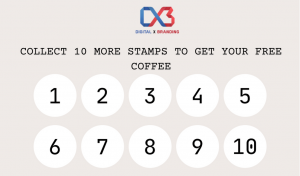
Today we are going to talk about some cognitive bias that I apply for my client during my branding work, this is one of the most common tactics given to help my client to boost their sales without needing to spend more money on promotion. What’s the magic trick? By applying some cognitive bias trick like the Goal Gradient Effect.
Goal Gradient Effect
What is Goal Gradient Effect? In short, it explains why human works harder or put more effort (accelerate) when they feel that they are closer to their goal.
The Research
The research done by American psychologist Clark Hull developed the Goal Gradient Effect hypothesis by conducting experiments with rats. He noticed that the rats run faster as they approach a food reward. Another experiment: The Goal-Gradient Hypothesis Resurrected: Purchase Acceleration, Illusionary Goal Progress, and Customer Retention by Kivetz, Urminsky, & Zheng, 2006 shows that human increases effort as they approaching the reward even with a illusion of the progress. And we are going to talk about it here, how you can use that to make your customer to purchase even more.
How to make Buy 10 Free 1 More Effective?
With Goal Gradient Effect, we can directly apply this to any loyalty or reward program that uses stamp collection and reward customers with certain reward. This is most commonly used in some of the famous bubble tea shop in the town, if you noticed.
So how to make your customer to buy more with your Buy 10 Free 1 Campaign? If you understand the Goal Gradient Effect, it means if that person feels that they are closer to the reward, they will put more effort towards it. The key here is feels they are close towards the reward.
Use The example below:
The most common loyalty reward card looks like the image above, collect 10 more stamps to get your free coffee, in this image, the narrative of the user will be I have to collect 10 more stamps to get 1 free Coffee, might not be so worth it?
What if the we don’t reduce the number of stamps (maintain buy 10 free 1) and able to make them feel they are closer to their goals? Here we apply Goal Gradient Effect on the second card.
By just extending the number of stamps needed, and give them 2 bonus stamps during the first time they get the card, this creates a narrative of 2/12 instead of 0/10, meaning they need less effort to complete their goal. The customer narrative will be focusing on: I already have 2 stamps as bonus, I will only need 10 more to hit the goal, it helps to motivate the customers even though they still need to buy 10 more to get the reward. Why? Because this 2 bonus stamps creates an illusion that they are closer to their goal? It makes customer feel easier to hit the goal.
Still don’t believe it? Why not try out at your own loyalty program? Since it doesn’t cost you extra marketing dollar, why not change to a Goal Gradient Effect card?
Summary
If you feel like to connect with us to design your own brand strategy with behavioural tactics such as cognitive bias, you can click here: Talk to Us
You can also follow Shen Feng on social media to learn more on branding : www.facebook.com/iamshenfeng
Research Paper Sources
Author




